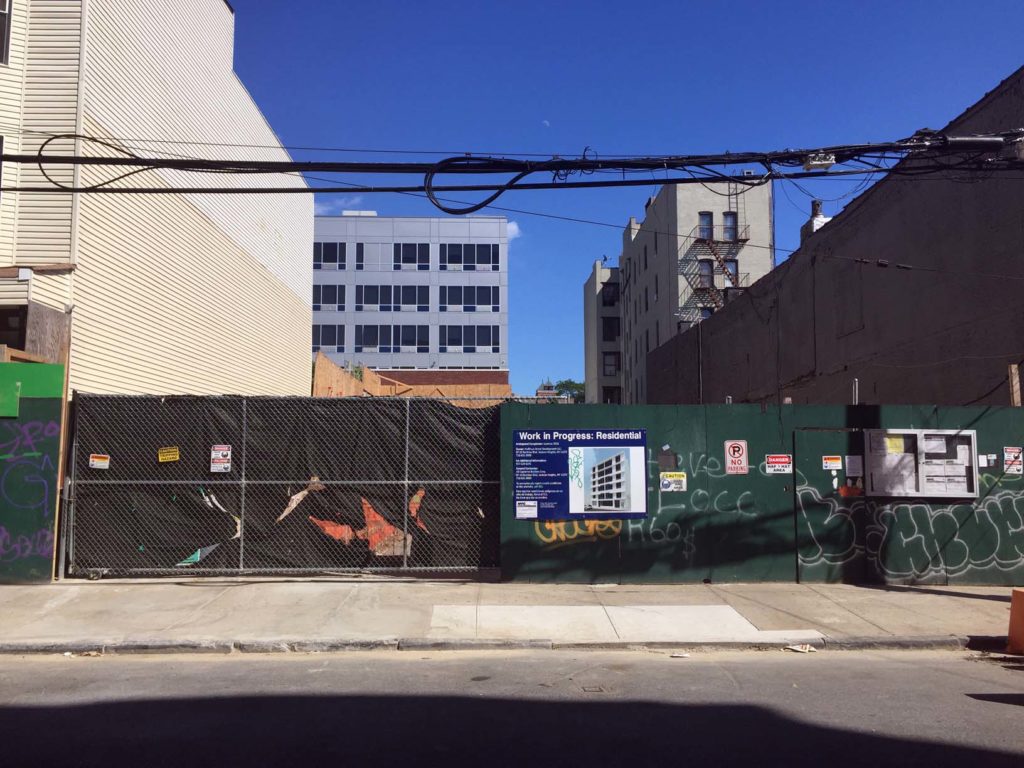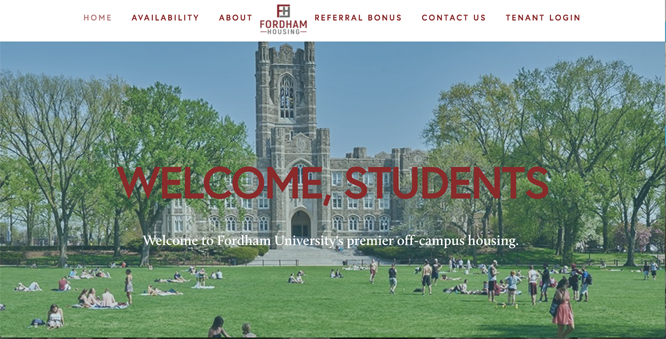The Bronx Develops: Luxury Student Housing Rises in Bronx’s Little Italy
The Norwood News, in partnership with WFUV and BronxNet TV, brings you a four-part series on development projects happening across the Bronx and its impact on community residents.
 Luxury Student Housing Rises in Bronx’s Little Italy" width="696" height="522" />CONSTRUCTION SITE FOR future luxury unit marketed for students on Hoffman Street in Belmont, a few blocks from Fordham University.
Luxury Student Housing Rises in Bronx’s Little Italy" width="696" height="522" />CONSTRUCTION SITE FOR future luxury unit marketed for students on Hoffman Street in Belmont, a few blocks from Fordham University.Photo by Jacob Shore
For Fordham University students, living off campus is a respite from on-campus housing prices and its rules. It’s worked for Brendan Batcheller, a senior at Fordham’s Gabelli School of Business. The public accounting major said living off campus is markedly cheaper than living within Fordham’s gates.
“The cost of a year’s rent for us is less than nine months’ worth of living in a dorm,” Batcheller said in an email. “There is definitely a greater sense of independence living off campus–having to deal with a landlord, paying utilities, fixing things as they come up, etc. provides a more realistic living situation than calling [a resident advisor] or Facilities whenever you have a problem.”
The demand has drawn developers to create off-campus housing in Belmont, dubbed the Bronx’s Little Italy and blocks from Fordham’s campus. This has worried some who view these developments as keeping permanent residents out. But the development comes with a twist—these days, luxury housing is trending. Developers like AB Capstone intend to give students an off-campus luxury alternative to Fordham dorms.
Currently under construction is AB Capstone’s third luxury housing unit, the first company to bring such housing to the neighborhood. Their most high profile residence is dubbed Artu Viale on Arthur Avenue, two blocks from the Arthur Avenue Retail Market. It was completed this spring.
Creative Director of AB Capstone Joseph Zanzuri said the apartments cost roughly $1000 per bedroom, though he did not elaborate further. But residents said one- and two-bedroom units typically go from $1500 to upwards of $3000.
Artu Viale and the property under construction on Hoffman Street are joined by a 30-person luxury residence on Lorillard Place, each a block away and marketed as an upscale option for students. Students have already moved into the Artu Viale and Lorillard properties.
“Arthur Avenue is a place for tourists and locals to shop and eat. But most of the people who do live in these houses around us are predominantly students. So how have we hurt the community by offering something better than there was before?” said Zanzuri. “More students are looking to live off campus nowadays.”
Another real estate firm marketing off-campus housing in Belmont include Brooklyn Standard Properties (BSP). They completed a deal last month to own a swath of buildings previously marketed as off-campus housing for Fordham students. The deal was finalized by co-founder David Manheimer who secured 104 rental units in 10 buildings, totaling their Fordham portfolio to 14 buildings since January.
Like Zanzuri, Manheimer said his company offers “premiere rentals for the neighborhood.” Manheimer said they won’t discourage other Bronx residents from living in their units, though they’ll prioritize their units to Fordham students.
 Luxury Student Housing Rises in Bronx’s Little Italy" width="666" height="339" />FRONT PAGE OF Brooklyn Standard Properties’ website, marketing campaign for Fordham students.
Luxury Student Housing Rises in Bronx’s Little Italy" width="666" height="339" />FRONT PAGE OF Brooklyn Standard Properties’ website, marketing campaign for Fordham students.Image courtesy Brooklyn Standard Properties
Their website, www.fordhamhousing.com, directly markets apartments to Fordham students, even suggesting they’re affiliated with the university. Fordham University does not sponsor off-campus housing developments, but companies like the BSP saw a market for students who wish to live off campus, said Manheimer. The website offers students $250 for every referral leading to a rental. “[W]e market towards students because I think that’s the highest supply of tenants in the neighborhood. It’s smart business to market that way,” he said.
But some worry that by continuing to market housing developments and properties to mostly Fordham students, a spot in housing is lost to someone who leaves after four years rather than someone looking to stay in the neighborhood long-term. District Manager of local Community Board 6 John Sanchez said when one markets housing exclusively for students, you can keep out young professionals looking to live there longer than four years.
[embedded content]
“We don’t want community residents to be denied the chances to have these apartments,” said Sanchez. “I think when you have an exclusive development or you market it as exclusively for students, that can create tension between residents and the students. And there shouldn’t be that tension because the students are a part of our community.”
Councilman Ritchie Torres, representing the neighborhood, said he’s not opposed to luxury student housing but would prefer more development in the area tailored to long-term residents and working professionals, like the Bronx’s many healthcare workers. “The key to deconcentrating poverty is to have a mix of incomes living in the neighborhood,” said Torres. “It’s a noble pursuit.” Torres said the new buildings going up have not displaced any residents so far, but he will be on the lookout for it.
For Frank Franz, treasurer of the Belmont Business Improvement District, students are vital to the Bronx, even if they only live there briefly. Franz, a lifelong Bronx resident, wants to see the borough build up the quality of Belmont’s housing developments not just for students, but for the borough’s teachers, police officers, and medical professionals. “You can’t get people of better means living here in crappy housing,” said Franz, “The neighborhood needs to be economically diversified.”
Belmont has historically been a delicate balance of Italian heritage, college town, and recent immigrants. The NYU Furman Center put the neighborhood in 2015 at 64.1 percent Hispanic, 29.7 percent black, and 4.5 percent white. The district also has the city’s highest unemployment rate with 44 percent of residents living below the federal poverty line.
Fordham University has changed from the small commuter college of years past to boasting three campuses and more than 6,000 undergraduate students at its Rose Hill location. Despite recent developments and increased renovations of properties to rent to students, Fordham University maintains that fewer students are moving off campus. By looking at the difference between housing deposits and number of students, university spokesman Bob Howe said around 500 to 1,000 students leave Fordham housing to live in Belmont. “Fordham students rent apartments across a variety of housing types in the local neighborhood, few of which could be described as luxury housing,” said Howe in an email.
For Sanchez, the development in Belmont should involve the community board so they can work on housing that balances both the population of students in the area with young professionals who work in the Bronx and are the future of the borough. “The students are a huge boon to the economy but in the same way so is the community that has been here for years.” Sanchez said, “I think having them coexist is a lot better than trying to separate university from the community. We should be intermingling.”
Comments
Post a Comment